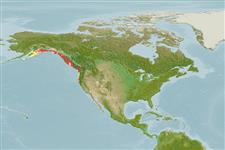Common names from other countries
Classification / Names / Names
Nomi Comuni | Sinonimi | Catalog of Fishes (gen., sp.) | ITIS | CoL | WoRMS
Environment: milieu / climate zone / depth range / distribution range
Ecologia
; distribuzione batimetrica 0 - 125 m (Ref. 95072). Temperate; 71°N - 32°N, 141°E - 117°W
Arctic and Northern Pacific.
Length at first maturity / Size / Peso / Age
Maturity: Lm ?, range 4 - 5 cm Max length : 19.0 cm WD maschio/sesso non determinato; (Ref. 128652); Età massima riportata: 200 anni (Ref. 128652)
Harvestable size is around 9-10 cm test diameter (4-5 years in age) (Ref. 121955). Found in relatively high energy environments on open rocky intertidal and subtidal shores (Ref. 121802). Herbivorous grazer in nearshore habitats (Ref. 121801). Kelp forest species (Ref. 121804). Found in concentrated amount at the apex of the holdfast of the giant kelp Macrocystis pyrifera (Ref. 121803).
Life cycle and mating behavior
Maturità | Riproduzione | Deposizione | Uova | Fecundity | Larve
Members of the class Echinoidea are gonochoric. Fertilization is external. Brooding is common, eggs are held either on the peristome, around the periproct or deep into the concavities on the petaloids. Life cycle: Embryos develop into planktotrophic larvae (echinoplateus) and live for several months before they sink to the bottom using their tube feet to adhere on the ground where they metamorphose into young urchins.
Bisby, F.A., M.A. Ruggiero, K.L. Wilson, M. Cachuela-Palacio, S.W. Kimani, Y.R. Roskov, A. Soulier-Perkins and J. van Hertum. 2005. (Ref. 19)
IUCN Red List Status (Ref. 130435)
CITES status (Ref. 108899)
Not Evaluated
Not Evaluated
Human uses
Pesca: commerciale
| FishSource |
Strumenti
Fonti Internet
Estimates based on models
Preferred temperature
(Ref.
115969): 4.1 - 10.7, mean 8.6 (based on 90 cells).
Resilienza
Basso, tempo minimo di raddoppiamento della popolazione 4.5 - 14 anni (K=0.08).
